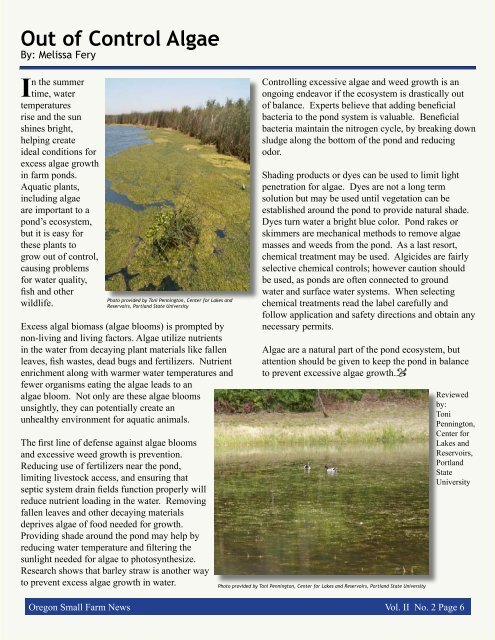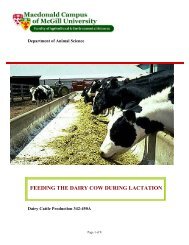Small Farm News - Oregon Small Farms - Oregon State University
Small Farm News - Oregon Small Farms - Oregon State University
Small Farm News - Oregon Small Farms - Oregon State University
Create successful ePaper yourself
Turn your PDF publications into a flip-book with our unique Google optimized e-Paper software.
Out of Control Algae<br />
By: Melissa Fery<br />
In the summer<br />
time, water<br />
temperatures<br />
rise and the sun<br />
shines bright,<br />
helping create<br />
ideal conditions for<br />
excess algae growth<br />
in farm ponds.<br />
Aquatic plants,<br />
including algae<br />
are important to a<br />
pond’s ecosystem,<br />
but it is easy for<br />
these plants to<br />
grow out of control,<br />
causing problems<br />
for water quality,<br />
fish and other<br />
wildlife.<br />
Photo provided by Toni Pennington, Center for Lakes and<br />
Reservoirs, Portland <strong>State</strong> <strong>University</strong><br />
Excess algal biomass (algae blooms) is prompted by<br />
non-living and living factors. Algae utilize nutrients<br />
in the water from decaying plant materials like fallen<br />
leaves, fish wastes, dead bugs and fertilizers. Nutrient<br />
enrichment along with warmer water temperatures and<br />
fewer organisms eating the algae leads to an<br />
algae bloom. Not only are these algae blooms<br />
unsightly, they can potentially create an<br />
unhealthy environment for aquatic animals.<br />
The first line of defense against algae blooms<br />
and excessive weed growth is prevention.<br />
Reducing use of fertilizers near the pond,<br />
limiting livestock access, and ensuring that<br />
septic system drain fields function properly will<br />
reduce nutrient loading in the water. Removing<br />
fallen leaves and other decaying materials<br />
deprives algae of food needed for growth.<br />
Providing shade around the pond may help by<br />
reducing water temperature and filtering the<br />
sunlight needed for algae to photosynthesize.<br />
Research shows that barley straw is another way<br />
to prevent excess algae growth in water.<br />
Controlling excessive algae and weed growth is an<br />
ongoing endeavor if the ecosystem is drastically out<br />
of balance. Experts believe that adding beneficial<br />
bacteria to the pond system is valuable. Beneficial<br />
bacteria maintain the nitrogen cycle, by breaking down<br />
sludge along the bottom of the pond and reducing<br />
odor.<br />
Shading products or dyes can be used to limit light<br />
penetration for algae. Dyes are not a long term<br />
solution but may be used until vegetation can be<br />
established around the pond to provide natural shade.<br />
Dyes turn water a bright blue color. Pond rakes or<br />
skimmers are mechanical methods to remove algae<br />
masses and weeds from the pond. As a last resort,<br />
chemical treatment may be used. Algicides are fairly<br />
selective chemical controls; however caution should<br />
be used, as ponds are often connected to ground<br />
water and surface water systems. When selecting<br />
chemical treatments read the label carefully and<br />
follow application and safety directions and obtain any<br />
necessary permits.<br />
Algae are a natural part of the pond ecosystem, but<br />
attention should be given to keep the pond in balance<br />
to prevent excessive algae growth.<br />
Photo provided by Toni Pennington, Center for Lakes and Reservoirs, Portland <strong>State</strong> <strong>University</strong><br />
Reviewed<br />
by:<br />
Toni<br />
Pennington,<br />
Center for<br />
Lakes and<br />
Reservoirs,<br />
Portland<br />
<strong>State</strong><br />
<strong>University</strong><br />
<strong>Oregon</strong> <strong>Small</strong> <strong>Farm</strong> <strong>News</strong> Vol. II No. 2 Page 6















